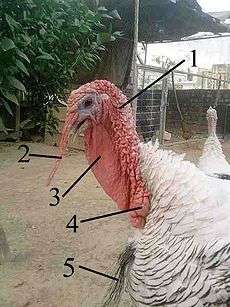Snood (anatomy)

In anatomical terms, the snood is an erectile, fleshy protuberance on the forehead of turkeys. Most of the time when the turkey is in a relaxed state, the snood is pale and 2-3 cm long. However, when the male begins strutting (the courtship display), the snood engorges with blood, becomes redder and elongates several centimetres, hanging well below the beak (see image).[1][2]
Snoods are just one of the caruncles (small, fleshy excrescences) that can be found on turkeys.
While fighting, commercial turkeys often peck and pull at the snood, causing damage and bleeding. This often leads to further injurious pecking by other turkeys and sometimes results in cannibalism. To prevent this, some farmers cut off the snood when the chick is young, a process known as desnooding.
Function
The snood functions in both intersexual and intrasexual selection. Captive female wild turkeys prefer to mate with long-snooded males, and during dyadic interactions, male turkeys defer to males with relatively longer snoods. These results were demonstrated using both live males and controlled artificial models of males. Data on the parasite burdens of free-living wild turkeys revealed a negative correlation between snood length and infection with intestinal coccidia, deleterious protozoan parasites. This indicates that in the wild, the long-snooded males preferred by females and avoided by males seemed to be resistant to coccidial infection.[3]
See also
References
- ↑ ENature.com (2010). "Snoods and wattles? A turkey's story". Retrieved May 3, 2013.
- ↑ Graves, R.A. (2005). "Know your turkey parts.". Retrieved May 3, 2013.
- ↑ Buchholz, R. "Mate choice research". Retrieved May 3, 2013.